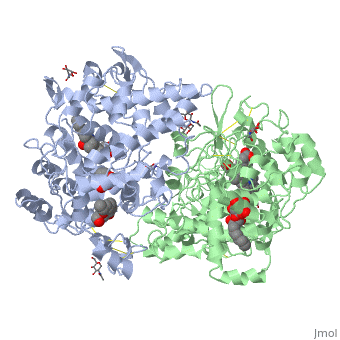Aspirin effects on COX aka PGHS
From Proteopedia
(Difference between revisions)
(→About this Structure) |
|||
| Line 3: | Line 3: | ||
<StructureSection load='1pth' size='340' side='right' caption='Caption for this structure'cyclooxygenase I scene=''> | <StructureSection load='1pth' size='340' side='right' caption='Caption for this structure'cyclooxygenase I scene=''> | ||
| - | Aspirin, also known as acetyl salicylic acid or ASA, has been used as an antipyretic drug (reduces fever) and as an anti-inflammatory agent (reduces swelling and redness due to inflammation) from ancient times. Chewing on willow bark was a headache and toothache remedy for American Indians<ref>http://www.bellaonline.com/articles/art8190.asp</ref>, and Dioscorides, the first century Greek physician, recommended it as a poultice for treating inflammation in his De Materia Medica Libri .<ref name="Mayer"> Quinque Mayer R, Mayer M. Mayer R, Mayer M. Biological salicyltherapy with cortex salicus [Weidenrinde]. Pharmazie 1949;4:77-81.</ref>. Aspirin is in the family of drugs known as NSAIDs, which stands for '''N'''on'''S'''teroidal '''A'''nti'''I'''nflammatory '''D'''rugs. | + | [[Aspirin]], also known as acetyl salicylic acid or ASA, has been used as an antipyretic drug (reduces fever) and as an anti-inflammatory agent (reduces swelling and redness due to inflammation) from ancient times. Chewing on willow bark was a headache and toothache remedy for American Indians<ref>http://www.bellaonline.com/articles/art8190.asp</ref>, and Dioscorides, the first century Greek physician, recommended it as a poultice for treating inflammation in his De Materia Medica Libri .<ref name="Mayer"> Quinque Mayer R, Mayer M. Mayer R, Mayer M. Biological salicyltherapy with cortex salicus [Weidenrinde]. Pharmazie 1949;4:77-81.</ref>. Aspirin is in the family of drugs known as NSAIDs, which stands for '''N'''on'''S'''teroidal '''A'''nti'''I'''nflammatory '''D'''rugs. |
While the use of aspirin goes back to ancient times, the mechanism of how aspirin relieves pain is relatively modern. In 1971, John Vane discovered that aspirin works by inhibiting the synthesis of prostaglandins <ref>PMID:5284360</ref>, and he recieved a Nobel Prize for this work in 1982 <ref>http://nobelprize.org/nobel_prizes/medicine/laureates/1982/vane-lecture.html</ref>. In 1975 Roth, Standford, and Majerus identified prostaglandin H2 synthase, also referred to as cyclooxygenase (COX), as the enzyme that aspirin inhibits<ref>PMID 810797</ref>. | While the use of aspirin goes back to ancient times, the mechanism of how aspirin relieves pain is relatively modern. In 1971, John Vane discovered that aspirin works by inhibiting the synthesis of prostaglandins <ref>PMID:5284360</ref>, and he recieved a Nobel Prize for this work in 1982 <ref>http://nobelprize.org/nobel_prizes/medicine/laureates/1982/vane-lecture.html</ref>. In 1975 Roth, Standford, and Majerus identified prostaglandin H2 synthase, also referred to as cyclooxygenase (COX), as the enzyme that aspirin inhibits<ref>PMID 810797</ref>. | ||
Current revision
Contents |
ASPIRIN'S ANTI-INFLAMMATORY EFFECTS UPON PROSTAGLANDIN H2 SYNTHASE (CYCLOOXYGENASE)
| |||||||||||
About this Structure
1PTH is a 2 chains structure of sequences from Ovis aries. The May 2001 RCSB PDB Molecule of the Monthby David S. Goodsell features Cyclooxygenase. [1]. Full crystallographic information is available from OCA.
Other Tutorials
- The effect of ASPIRIN: the irreversible inhibition of Cyclooxygenase-1 is a more detailed tutorial by Andreas Brink, Technische Universität Dortmund. Also available in German/Auch in deutscher Sprache erhältlich.
References
- ↑ http://www.bellaonline.com/articles/art8190.asp
- ↑ Quinque Mayer R, Mayer M. Mayer R, Mayer M. Biological salicyltherapy with cortex salicus [Weidenrinde]. Pharmazie 1949;4:77-81.
- ↑ Vane JR. Inhibition of prostaglandin synthesis as a mechanism of action for aspirin-like drugs. Nat New Biol. 1971 Jun 23;231(25):232-5. PMID:5284360
- ↑ http://nobelprize.org/nobel_prizes/medicine/laureates/1982/vane-lecture.html
- ↑ Roth GJ, Stanford N, Majerus PW. Acetylation of prostaglandin synthase by aspirin. Proc Natl Acad Sci U S A. 1975 Aug;72(8):3073-6. PMID:810797

